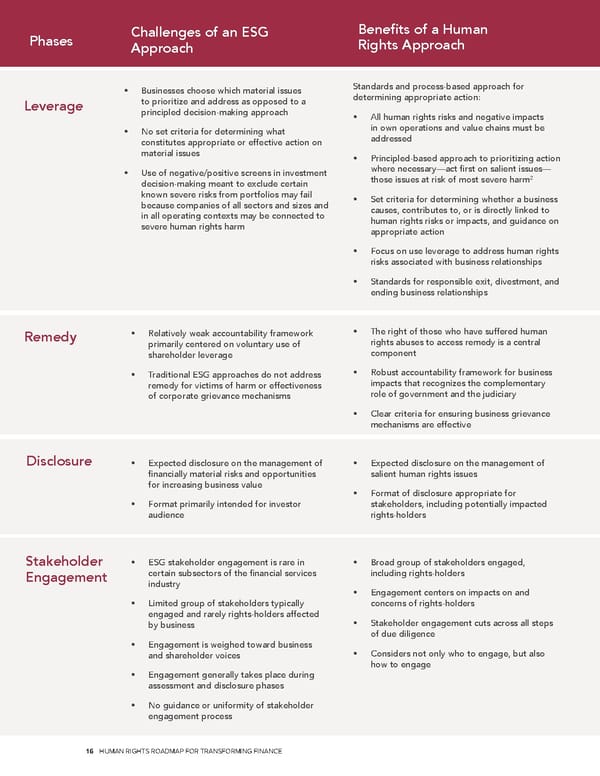Phases Challenges of an ESG Benefits of a Human Approach Rights Approach • Businesses choose which material issues Standards and process-based approach for Leverage to prioritize and address as opposed to a determining appropriate action: principled decision-making approach • All human rights risks and negative impacts • No set criteria for determining what in own operations and value chains must be constitutes appropriate or effective action on addressed material issues • Principled-based approach to prioritizing action • Use of negative/positive screens in investment where necessary—act first on salient issues— decision-making meant to exclude certain those issues at risk of most severe harm2 known severe risks from portfolios may fail • Set criteria for determining whether a business because companies of all sectors and sizes and causes, contributes to, or is directly linked to in all operating contexts may be connected to human rights risks or impacts, and guidance on severe human rights harm appropriate action • Focus on use leverage to address human rights risks associated with business relationships • Standards for responsible exit, divestment, and ending business relationships Remedy • Relatively weak accountability framework • The right of those who have suffered human primarily centered on voluntary use of rights abuses to access remedy is a central shareholder leverage component • Traditional ESG approaches do not address • Robust accountability framework for business remedy for victims of harm or effectiveness impacts that recognizes the complementary of corporate grievance mechanisms role of government and the judiciary • Clear criteria for ensuring business grievance mechanisms are effective Disclosure • Expected disclosure on the management of • Expected disclosure on the management of financially material risks and opportunities salient human rights issues for increasing business value • Format of disclosure appropriate for • Format primarily intended for investor stakeholders, including potentially impacted audience rights-holders Stakeholder • ESG stakeholder engagement is rare in • Broad group of stakeholders engaged, Engagement certain subsectors of the financial services including rights-holders industry • Engagement centers on impacts on and • Limited group of stakeholders typically concerns of rights-holders engaged and rarely rights-holders affected • Stakeholder engagement cuts across all steps by business of due diligence • Engagement is weighed toward business • Considers not only who to engage, but also and shareholder voices how to engage • Engagement generally takes place during assessment and disclosure phases • No guidance or uniformity of stakeholder engagement process 16 HUMAN RIGHTS ROADMAP FOR TRANSFORMING FINANCE
 Human Rights Roadmap for Transforming Finance Page 15 Page 17
Human Rights Roadmap for Transforming Finance Page 15 Page 17